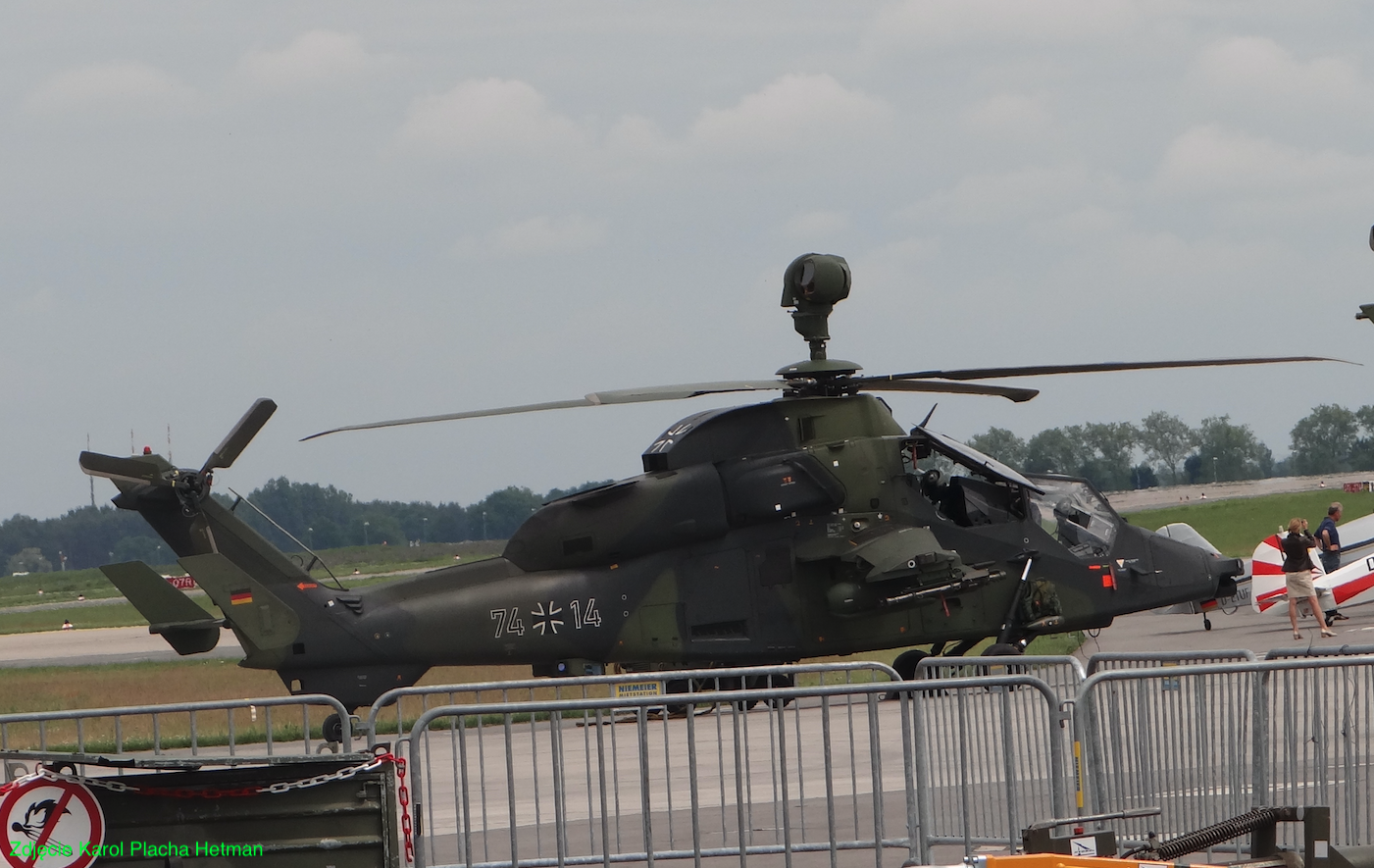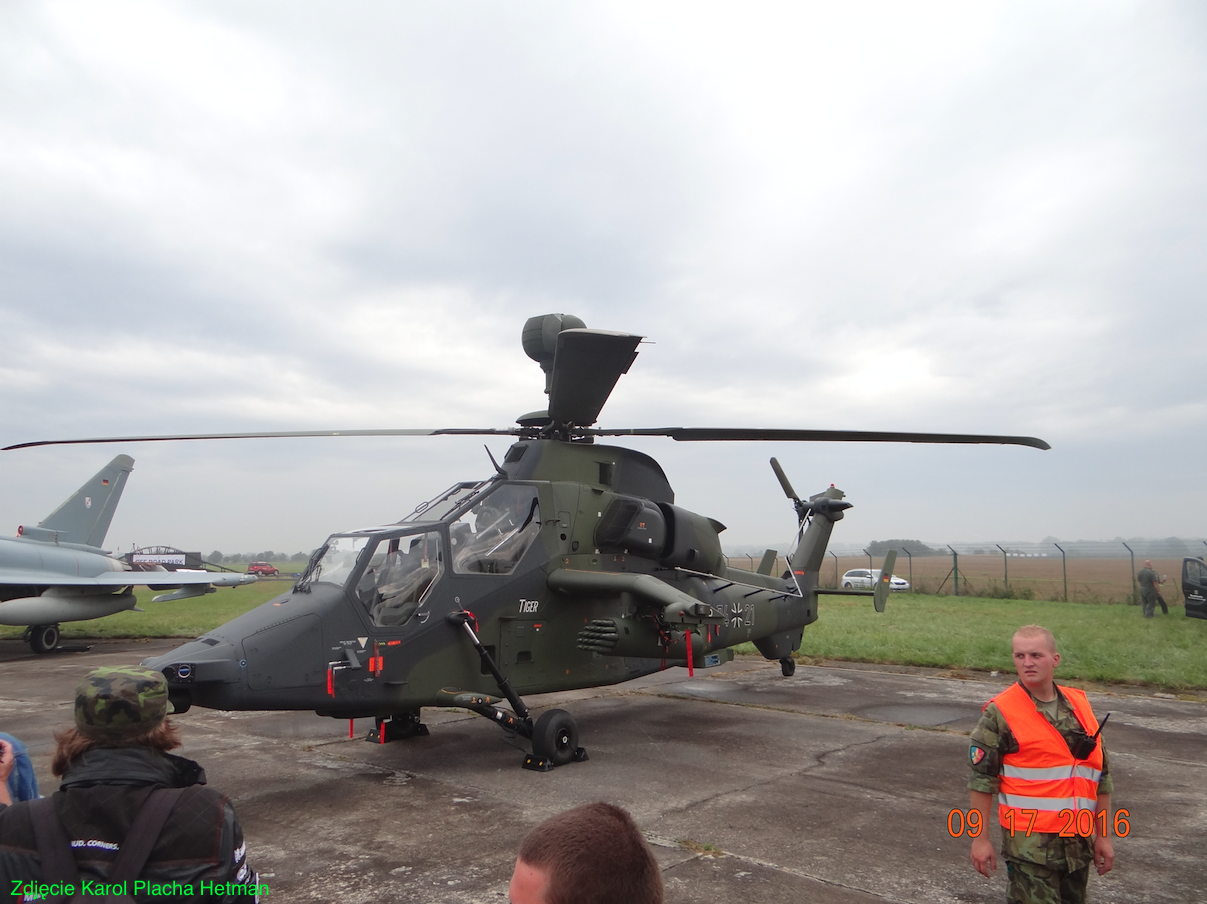Warszawa 2023-04-14
Eurocopter Tiger.
Eurocopter Tiger to jest śmigłowiec szturmowy przeznaczony do działań bezpośrednio na polu walki. Prototyp śmigłowca pierwszy lot wykonał w dniu 27 kwietnia 1991 roku. Śmigłowiec jest produkowany przez firmę Airbus Helicopters, dawniej Eurocopter. Firma Airbus Helicopters powstała z połączenia odpowiednich działów śmigłowców firm Aérospatiale i DASA. Oznaczenie fabryczne śmigłowca to EC.665. Śmigłowiec Eurocopter Tiger został zbudowany w układzie klasycznym. Do napędu użyto dwa silniki turbinowe. Wprowadzenie do służby nastąpiło dopiero w 2003 roku. Do 2019 roku, zbudowano 180 egzemplarzy. Śmigłowiec jest eksploatowany w wojsku: Francja, RFN, Hiszpania, Australia.
Rozwój śmigłowca.
Rozwój śmigłowca rozpoczął się w 80-latach XX wieku, w czasie trwania „Zimnej Wojny”. W 1984 roku, rządy Francji i RFN zawarły porozumienie dla zbudowania wspólnej platformy śmigłowca. Jego głównym zadaniem miało być niszczenie sowieckiej broni pancernej, po ataku państwa moskiewskiego na Zachód. Poszczególne wersje narodowe miały się różnić wyposażeniem i zastosowanym uzbrojeniem. Dla realizacji programu założono spółkę joint venture, składającą się z Aérospatiale i MBB. Jednak okazało się, że wspólny program (Francja, RFN) będzie droższy od tego, gdyby każdy kraj opracował własny śmigłowiec (?). W 1986 roku, program został anulowany.
Po kilkunastu miesiącach, ponownie zaczęto analizować program. W wyniku analiz wydłużono czas trwania umowy na czas nieokreślony, co jednak uderzało w firmy prywatne, które chciały być udziałowcami, bo mogłyby nie doczekać się zysków. W temacie elektroniki pozostała tylko firma Thomson CSF.
Program został wznowiony w listopadzie 1987 roku. Utworzono jedno biuro projektowe, w skład którego weszli inżynierowie z Francji i RFN. W tym momencie, położono większy nacisk na zdolności przeciwpancerne śmigłowca szturmowego. W 1989 roku, podpisano umowę o finansowaniu programu, aż do uruchomienie dwóch linii produkcyjnych, odpowiednio; w zakładach Aerospatiale w Marignane i zakładach MBB w Donauwörth. Zdecydowano się na budowę pięciu prototypów. Pierwszy prototyp śmigłowca Tiger wykonał pierwszy lot w dniu 27 kwietnia 1991 roku.
Jednak w chwili, kiedy śmigłowiec EC.665 wykonał swój pierwszy lot, CCCP się rozpadł i Układ Warszawski został rozwiązany. Planowano zakończyć program śmigłowca. Ostatecznie, po kilkunastu miesiącach, Francja i RFN zdecydowały się kontynuować program poddając go modyfikacji. Chodziło o rozszerzenie możliwości bojowych śmigłowca. Lecz finansowanie programu było nierytmiczne, co znacznie wydłużało prace badawczo – rozwojowe.
W 1992 roku, firmy Aérospatiale i MBB połączyły się, tworząc Eurocopter Group. Doprowadziło to do znacznej konsolidacji przemysłu lotniczego i samego projektu Tiger. Jednak prace posuwały się wolno. Dopiero w 1996 roku, wybrano typ nowej generacji podstawowego pocisku przeciwpancernego dla śmigłowca.
W tym czasie Turcja była zainteresowana wejściem do programu Tiger. Jednak kolejne kontrowersje pomiędzy Francją i RFN, doprowadziły do odstąpienia Turcji od ewentualnego udziału.
W dniu 18 czerwca 1999 roku, RFN i Francja publicznie złożyły zamówienia na pierwszą partię 160 śmigłowców Tiger, po 80 egzemplarzy dla każdego kraju, o wartości 3,3 miliarda euro. W dniu 22 marca 2002 roku, nastąpił „Rollout” pierwszego seryjnego śmigłowca. W kolejnych latach liczbę zamówionych śmigłowców zmniejszono. W 2008 roku, śmigłowce osiągnęły gotowość bojową.
W tym czasie (2010 rok) cena jednego śmigłowca Eurocopter Tiger wynosiła 55 – 65 milionów $US. Śmigłowiec był oferowany wielu państwom, ale ostatecznie został kupiony tylko przez Hiszpanię i Australię. Zwykle śmigłowiec przegrywał ze śmigłowcem Boeing AH-64 Apache. Także Wojsku Polskiemu był oferowany śmigłowiec Tiger, w miejsce śmigłowców Mil Mi-24. Ale strona Polska nigdy nie wyrażała większego zainteresowania tą konstrukcją.
Konstrukcja Eurocopter Tiger.
Śmigłowiec zbudowany jest w układzie klasycznym. Maszyna nie posiada ładowni i nie nadaje się do ewakuacji rannych żołnierzy, ani dostarczenia obrońcom amunicji.
Tiger ma „szklany kokpit” z siedzeniami w układzie tandem i jest obsługiwany przez dwuosobową załogę; pilot zajmuje przedni fotel, a strzelec siedzi z tyłu. Każdy z członków załogi może zarządzać systemami uzbrojenia lub podstawowymi elementami sterującymi lotem, zmieniając role w razie konieczności. Kadłub Tygrysa jest wykonany w 80% z polimeru wzmocnionego włóknem węglowym i kevlaru, w 11% z aluminium i w 6% z tytanu. Cała część ogonowa jest wykonana z kompozytów, w tym jednoczęściowa belka ogonowa. Wirniki składa się z czterech łopat, jest kompozytowy z włókna szklanego. W strukturze kadłuba śmigłowca jest siatka i folia wykonane z miedzi i brązu, które stanowią masę ujemną, chroniącą przed piorunem i elektrycznymi przepięciami.
Systemy ochrony zastosowane w Tigerze obejmują cechy „Stealth”. Aspekty, takie jak sygnatury wizualne, radarowe, w podczerwieni i akustyczne, zostały zminimalizowane. Zastosowanie materiałów kompozytowych w płatowcu zaowocowało zmniejszeniem przekroju echa radaru (RCS), sygnatur w podczerwieni i akustycznych. Kadłub śmigłowca jest opancerzony i został opracowany tak, aby wytrzymać ostrzał z broni strzeleckiej i pociski z armaty 23 mm (0,91 cala). Śmigłowiec jest wyposażony w różne radarowe i laserowe systemy ostrzegania i wykrywania zbliżających się pocisków.
Napędem śmigłowca są dwa silniki turbinowe MTU Turbomeca Rolls-Royce MTR390 kontrolowane przez FADEC. Każdy silnik jest o mocy 972 kW (1 303 KM). Przekładnia główna jest przystosowana do 60-minutowej pracy na sucho, w przypadku utraty smarowania. Zbiorniki paliwa są samouszczelniające.
Podstawowym elementem systemu celowniczego śmigłowca jest głowica opto-elektroniczna „Ozyrys”, zwykle montowana na maszcie nad wirnikiem. Możliwe jest także montowanie głowicy na dachu śmigłowca pod wirnikiem. Załoga może korzystać z celowników montowanych na hełmie.
Dane T-T Tiger:
Załoga dwóch lotników. Długość kadłuba 14,08 m (46 stóp 2 cale). Wysokość 3,83 m (12 stóp 7 cali). Średnica wirnika nośnego 13,00 m (42 stopy 8 cali). Powierzchnia wirnika nośnego 132,75 m2 (1 428,9 stóp 2). Masa własna 3 060 kg (6 746 funtów). Masa startowa 5 090 kg (11 222 funtów). Masa maksymalna 6 000 kg (13 228 funtów). Paliwo 1 080 kg (2 381 funtów). Prędkość maksymalna 290 km/h (180 mph, 160 kn). Zasięg 800 km (500 mil, 430 mil morskich). Zasięg przebazowania 1 300 km (810 mil, 700 mil morskich). Pułap użytkowy 4 000 m (13 000 stóp). Prędkość wznoszenia 10,7 m/s (2 110 stóp/min).
Uzbrojenie: jedno działko kalibru 30 mm (1,18 cala), typu GIAT 30. Zapas nabojów 450 sztuk. Cztery zaczepy dla uzbrojenia.
Opracował Karol Placha Hetman


